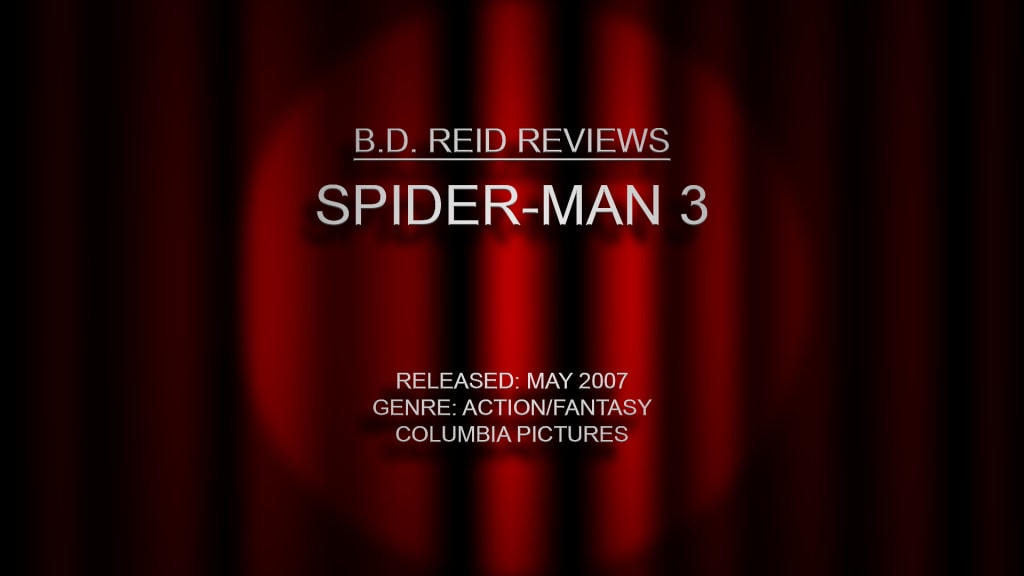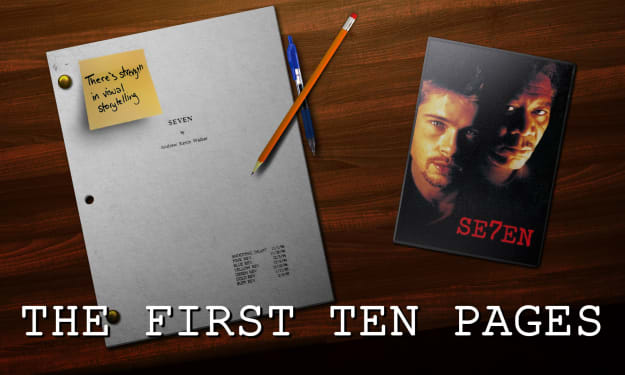
I got to see this movie in theatres. I remember being overjoyed to see Venom on the big screen and watch Spider-man fight crime in the Black Suit. Even though I had started my journey into film only a year or so previously, when the movie was finished, I knew that there was something off about it. I hated it. So much so that I haven’t actually seen it in about five years or so. Rewatching it, I’m astounded to learn that, not only are there some amazing moments in the film, but overall, it’s not nearly as bad as I remember.
Don’t misunderstand me, I still feel as though this is probably the weakest Spider-man movie out there, but with my new theory that these films are essentially just rom-coms masquerading as superhero films, and having rewatched the other two very recently, I’m starting to realize that this movie simply isn’t as bad as everyone says it is, at least in relation to the other two. The entire trilogy is composed of silly and dorky Tobey Maguire trying to win over Mary Jane and struggle with his responsibility of being the wall-crawler. I think the main thing was that, by then, people were just starting to get tired of the silliness and weren’t ready for three villains in the film.
Nowadays, we don’t even bat an eye for multiple villains (Homecoming had four; Into the Spider-verse had at least eight, most MCU movies feature at least two), so I just don’t think this film feels as overstuffed as it used to. And they are given a decent amount of time to be set up.
And these villains all relate to the central theme of the film: the choices we make and battling the darkness within. This is, again, a further continuation of the central crux of Spider-man: responsibility. This time, Spidey is faced with three different villains who function on three different sides of this argument and reflect his own personal problems.
New Goblin, aka Harry, has been being set up since the first Spider-man, so his motivations and goals are already established, but we still get a few lines of dialogue and visual cues that clue us in. I’ll admit that seeing the more comedic James Franco was a welcome change of pace, and it’s great to see him and Peter as friends again. The ending in which Harry comes in to rescue his friend, sacrifice himself, and prove to be better than his father is a perfect way to conclude his story and embody the theme. He starts out letting the darkness consume him, has a brief reprieve when he loses his memory, immediately returns to his darkness when he gets over his amnesia, and then makes the choice to do the right thing in the end, expelling the darkness within. The way that it’s written can come across as disjointed, dorky, or even convenient, with his only choosing to help Peter after the truth about his father is revealed, but if you look at his expressions when Peter asks for help, you can see the conflict on his face. I don’t know if that’s because James Franco is such a good actor, or if that was intentional, but I think Harry is a great mentor-esque villain for Peter.
Sandman, portrayed by Thomas Hayden Church, has the most phenomenal moments in the film. He’s introduced running from the law into his old apartment to visit his sick and dying daughter. He also gets reintroduced as the Sandman through the scene “Birth of the Sandman.” Both introductions are heavily visual, requiring little to no dialogue, and rely on body language to get the sense of the characters involved. He’s presented to us as Uncle Ben’s true killer (retconning the first movie, which always bugged me, but I digress), but throughout the story, we just see him with one goal in mind: save his daughter. This one motivation drives him throughout the movie, but he sees being a criminal as the only way to achieve this goal. Truthfully, this is very realistic, as there are a ton of people who are struggling this badly to make ends meet and there are definitely people out there who are wealthy because of a life of crime. I always figured that it worked like any job, though, requiring talent, skill, intuition. Because of this mentality and his love for his daughter, we understand that Flint Marko is not necessarily a bad person, though he is making bad choices. He’s not evil, but he’s letting his darkness win.
And then we come to Edward Brock Jr., aka Eddie, portrayed by Topher Grace. So, Eddie is definitely not the Eddie from the comics and was done more respectably in Venom (2018). However, as a dark version of Peter Parker, he does the job well. The lack of Venom that was in this movie was, and still is, my biggest disappointment in the film. Having said that, saving him for the climax is probably the thematic trajectory that this movie was going for. For years, I kept confusing Topher Grace and Tobey Maguire because I though they looked kind of similar, so I wasn’t that bothered by the casting (it was Foreman’s hair in “That 70s Show” that confused me). Eddie, in this one, is a slimier version of Peter. A brown-nosing suck-up that would do anything to get ahead, including photoshopping a picture of Spider-man robbing a bank. There’s a sense of narcissistic entitlement to him that just makes him… creepy.
As Venom, he outright says, “I like being bad: it makes me happy.” Thematically, this is a character who chooses to let the darkness rule within him and thus the climax, where the protagonist and antagonist battle over the true meaning of the theme, has a little bit more weight to it. Eddie even dies just to hold onto that mindset.
But what about the romance? Well…
Even that feels well-developed here. From what I can gather, most people didn’t like how Mary Jane was just a damsel-in-distress plot device, used to make Spider-man look good. Trying to analyze these movies and understand what the intent was, I can safely say that, while this is not an incorrect statement, there is more to it than that. In the first one, she was just “the girl next door” who Peter wanted to be with, but they did have moments where they’re talking about their likes, dislikes, and building up a chemistry that does genuinely work by the end. In the second one, Mary Jane is frustrated by Peter’s lack of commitment to even being her friend, and calls him out on it, thereby causing him to lose and regain his powers. Mary Jane has more of an impact on Peter in Spider-man 2 than just being a basic DID (Damsel In Distress).
This is the only film in the trilogy that I feel really went back on her character. First off, while this is not an easy lesson to learn, any aspiring artist (no matter your medium) should know this: Not everyone is going to like you or everything that you do. I don’t necessarily understand why she gets replaced after one show instead of working on it with her, but that’s what understudies are for. Nevertheless, she bites Peter’s head off when he’s trying to relate to her situation by telling her about the times that he was victimized as Spider-man. She’s also talking to a boy who was bullied relentlessly in high school. He’s trying to help her understand that not everyone is going to like her but that doesn’t mean she should give up, but she’s being deliberately obtuse. Yes, she does say that it’s because she feels like her “father wrote these words,” but again, that’s just being an artist.
Additionally, she helps bring more romantic drama/comedy elements into the film: such as the unnecessary breakup (coupled with the “about to propose” cliché), cheating on her boyfriend, and being, basically, the reason that Peter goes emo. I know everyone talks about how she could’ve told Peter that Harry had his memory back, but here’s the thing: this movie paints her as selfish. I got the sense that she WANTED to dump Peter and this was just the perfect excuse. The only salvation that her character has is that she shows that it’s not just the superheroes that need support, but those in their personal lives that need help. I’d totally watch a movie about the trials and hardships of being romantically involved with a superhero. I get all of the emotional reasons behind Mary Jane’s character in this one, but she brings in some of the worst cliches of romantic movies and it just felt like a step too far.
Which pales in comparison to how far the film went in making Peter look dorky. Now, I’m not going to lie, when I first saw Peter with his hair down in his black tux, I thought it looked pretty cool. Having said that, I am a huge dork. With all the complaints against Peter being too emo in the movie, he’s only that way for about ten minutes or so. It is, however, extremely cringe-worthy, so much so that I can’t even watch the dance sequence. Haven’t since I saw it in theatres.
Having said all of that, Peter has been established as a complete dork and the symbiote does “amplify characteristics of it’s host,” so it stands to reason that it would accentuate the dorkiness. It does also lower his inhibitions and raise his confidence, so he just wouldn’t care about looking cool. Finally, there’s the fact that he acts EXACTLY as slimy as the main antagonist: Eddie Brock. So Peter going emo, while not dignified, is thematically appropriate. He doesn’t become emo Peter until about two-thirds of the way through the film. Basically, from the time he gets dumped to the part in the church covers the “midpoint” to the “break into three.”
Even Gwen kind of has a moment where she embodies the theme. She’s relatively innocent throughout most of the film, but when Peter does the dance and she realizes that he’s just using her, she immediately apologizes to Mary Jane and ditches Peter.
Rosemary Harris gets all of four scenes in the film, which I’m just realizing is not cool. I also noticed that she’s always the guiding force that helps launch Peter into the third act, too (she helps Peter realize that the Goblin is going after Mary Jane in Spider-man, reminds him what a hero is in Spider-man 2, and encourages him to not give up on MJ in this one).
I enjoyed how ambitious this film got in terms of it’s effects: having Peter in regular suit attire doing Spider-man stuff during his fight with Harry, the microscopic transformation of DNA to sand, battles that are fought while falling, and the gooey, almost possessed, feeling that the symbiote has. However, these effects do feel off in several shots. I think there was something weird about rendering them for during night-time sequences. There are a ton of times where the face-tracking is obvious, and some of the models looked too fake.
Thematically, I guess I do appreciate what this movie was trying to do. I don’t think it’s nearly as bad as it’s made out to be, but I can see, very easily, why it’s a disappointment. Mary Jane is evolved into a petty child, just vying for attention instead of the good-natured and kind-hearted person we’ve come to know. The tropes of romantic comedy, which were present in the previous ones, are made more pronounced here, thereby grating on the nerves. Some plot details don’t quite add up and there is a disjointed nature to them. The effects might not be as good, but they are a little more diversified. The camera work, lighting, and editing is all done well.
Overall, this film does have some amazing qualities to it, but when put together to make an unnecessarily tangled web. I do hope that we get a proper Alien Symbiote story-line someday, though.
About the Creator
B.D. Reid
A competition-recognized screenwriter and filmmaker, building to a career that satisfies my creative drive but allows me to have time for friends and family.






Comments
There are no comments for this story
Be the first to respond and start the conversation.